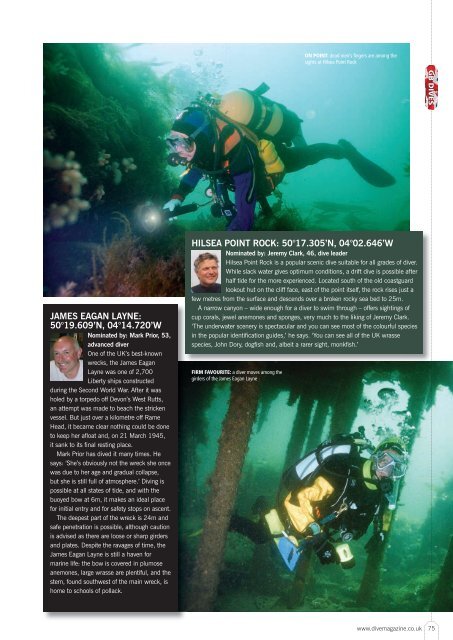the insider's guide to plymouth's greatest dives - Plymouth Sound ...
the insider's guide to plymouth's greatest dives - Plymouth Sound ...
the insider's guide to plymouth's greatest dives - Plymouth Sound ...
Create successful ePaper yourself
Turn your PDF publications into a flip-book with our unique Google optimized e-Paper software.
JAMES EAGAN LAYNE:<br />
50°19.609’N, 04°14.720’W<br />
Nominated by: Mark Prior, 53,<br />
advanced diver<br />
One of <strong>the</strong> UK’s best-known<br />
wrecks, <strong>the</strong> James Eagan<br />
Layne was one of 2,700<br />
Liberty ships constructed<br />
during <strong>the</strong> Second World War. After it was<br />
holed by a <strong>to</strong>rpedo off Devon’s West Rutts,<br />
an attempt was made <strong>to</strong> beach <strong>the</strong> stricken<br />
vessel. But just over a kilometre off Rame<br />
Head, it became clear nothing could be done<br />
<strong>to</strong> keep her afloat and, on 21 March 1945,<br />
it sank <strong>to</strong> its final resting place.<br />
Mark Prior has dived it many times. He<br />
says: ‘She’s obviously not <strong>the</strong> wreck she once<br />
was due <strong>to</strong> her age and gradual collapse,<br />
but she is still full of atmosphere.’ Diving is<br />
possible at all states of tide, and with <strong>the</strong><br />
buoyed bow at 6m, it makes an ideal place<br />
for initial entry and for safety s<strong>to</strong>ps on ascent.<br />
The deepest part of <strong>the</strong> wreck is 24m and<br />
safe penetration is possible, although caution<br />
is advised as <strong>the</strong>re are loose or sharp girders<br />
and plates. Despite <strong>the</strong> ravages of time, <strong>the</strong><br />
James Eagan Layne is still a haven for<br />
marine life: <strong>the</strong> bow is covered in plumose<br />
anemones, large wrasse are plentiful, and <strong>the</strong><br />
stern, found southwest of <strong>the</strong> main wreck, is<br />
home <strong>to</strong> schools of pollack.<br />
HILSEA POINT ROCK: 50°17.305’N, 04°02.646’W<br />
Nominated by: Jeremy Clark, 46, dive leader<br />
Hilsea Point Rock is a popular scenic dive suitable for all grades of diver.<br />
While slack water gives optimum conditions, a drift dive is possible after<br />
half tide for <strong>the</strong> more experienced. Located south of <strong>the</strong> old coastguard<br />
lookout hut on <strong>the</strong> cliff face, east of <strong>the</strong> point itself, <strong>the</strong> rock rises just a<br />
few metres from <strong>the</strong> surface and descends over a broken rocky sea bed <strong>to</strong> 25m.<br />
A narrow canyon – wide enough for a diver <strong>to</strong> swim through – offers sightings of<br />
cup corals, jewel anemones and sponges, very much <strong>to</strong> <strong>the</strong> liking of Jeremy Clark.<br />
‘The underwater scenery is spectacular and you can see most of <strong>the</strong> colourful species<br />
in <strong>the</strong> popular identification <strong>guide</strong>s,’ he says. ‘You can see all of <strong>the</strong> UK wrasse<br />
species, John Dory, dogfish and, albeit a rarer sight, monkfish.’<br />
FIRM FAVOURITE: a diver moves among <strong>the</strong><br />
girders of <strong>the</strong> James Eagan Layne<br />
ON POINT: dead men’s fingers are among <strong>the</strong><br />
sights at Hilsea Point Rock<br />
GB DIVES<br />
www.divemagazine.co.uk 75


